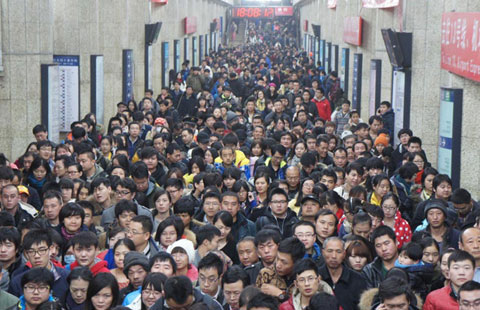Fast or slow, China needs new path to grow
(Xinhua) Updated: 2014-04-16 21:46BEIJING - The guessing game over China's economy is over, but just for now.
The National Bureau of Statistics said Wednesday that China's year-on-year GDP growth slowed to 7.4 percent in the first quarter, lower than the full-year target of 7.5 percent but higher than the 7.3 percent widely expected among economists.
The growth rate should be no cause for panic. Globally, the world economy is still struggling through the financial crisis, and domestically, problems are still deeply rooted in the financial and property sectors, which will inevitably weigh on growth in the world's second-largest economy.
Nonetheless, 7.4-percent quarterly GDP growth is not a level that can drag China into the abyss of collapse, but neither will it trigger a massive stimulus the size of that seen in 2009, even though some are desperately crying for it.
For major economies, China's latest GDP data remain enviable, given the 2.8-percent GDP growth for the G20 countries, which contribute about 85 percent of global economic output.
It's not the first time for China's quarterly GDP to fall short of the government's annual GDP growth target. For example, its GDP growth barely reached 6.6 percent year on year in the first quarter of 2009. In 2001, when China joined the World Trade Organization, the full-year growth rate was merely 7.3 percent. The Asian financial crisis in 1998, the most recent massive crisis until the global financial meltdown, also slumped China's GDP growth to only 7.1 percent.
For a long time, too many people have paid too much attention to the speed of China's GDP growth, while too few have cared about its quality.
The excessive concerns over short-term GDP data can easily make people obsessed with GDP as the sole criterion for economic success ignore other development goals, like residential income, employment and air quality, which have sparked frequent protests and complaints in the country.
Based on the growth-at-all-costs mentality, some projections by investment banks seem nonsensical as they blame the Chinese government's crackdown on corruption and prostitution for some of the economic slowdown.
When it comes to economic growth speed and quality, slower growth offers China not only a stress test for its unsustainable growth model, which relies too much on investment and credit binge, but also a rare opportunity to rethink the direction it should take to sustain the economy.
As the world's second-largest economy, a richer China needs to prioritize economic quality through industrial restructuring and upgrading, rather than the indiscriminate short-term growth that has choked the skies, tainted rivers and polluted the soil in the past,
China is now in a transition period of boosting productivity and advancing economic quality. Launching another massive stimulus package, as speculated by some analysts, is not in the interests of the country, nor is it within its capacity due to exploding debt levels and asset bubbles in recent years.
Therefore, a wait-and-see tactic would serve Chinese policymakers best now, as the economy is within the "proper range, " marked by tamed inflation and a relatively robust job market.
To seek a new path that is less dependent on investment and more reliant on innovation and consumption, slower growth is a cost China must pay for healthier sustained growth.
To reshape a more competitive and productive Chinese economy, stimulus measures should only be put in place during exceptional times, such as crises, not used as a regular weapon. If a pistol is enough, one doesn't need to carry a bazooka all day long.
Those who cry for massive stimulus the size of that in 2009 are pointing toward a wrong path for China, much like a dog barking up the wrong tree.
- Cheaper coal imports cause losses locally
- China stock index futures close mixed Wednesday
- China releases first monthly nonferrous metals index
- Alibaba reports strong growth before IPO
- New York Auto Show set to hit the road
- Chinese stocks close higher Wednesday
- China's industrial production picks up in March
- Cooling property sector in focus as economy slows

















